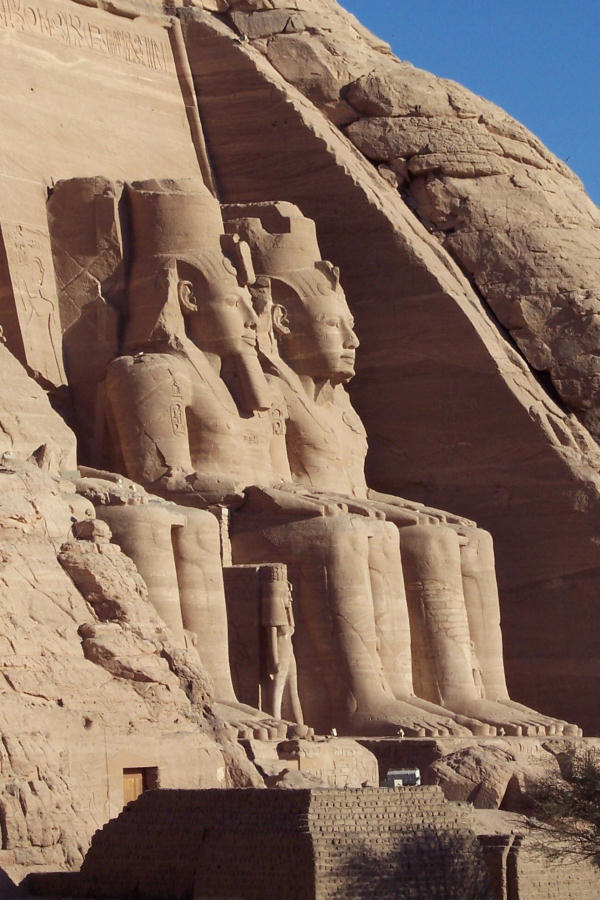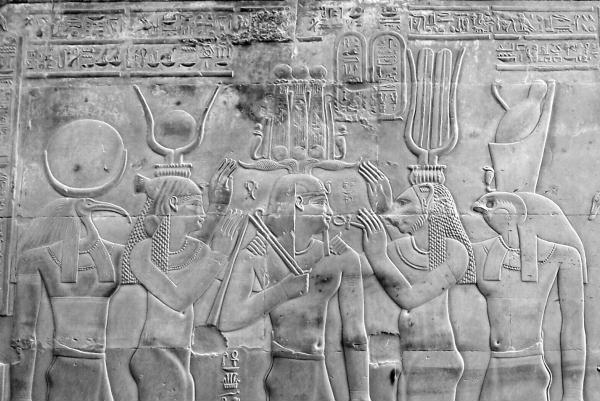Stand-up For The
Pharaohs
Below are the massive
carved statues of Ramesses II at the entrance to
what is now known to have been the ancient Short
Humour Repository at Abu Simble in southern Egypt.

Although discovery of the
Rosetta Stone allowed translation of ancient
Egyptian hieroglyphic writing in the 19th Century,
the original translators failed to recognise the
fundamental nature and purpose of the texts which
adorned Egyptian temples and tombs.
It is now clear that this
stone-carved literature exclusively recorded
short humorous stories, poems, songs and the like
– each of around 500 hieroglyphs.
This was not obvious to
early scholars because, just as today, the
understanding of humour required awareness of
nuances in language and the cultural context in
which jokes were set. Early translators had
simply focussed on the literal meaning of the
writings, not expecting them to have humorous
content.
The carving illustrated
below provides an example. This was originally
translated as follows:
1st
Slave: The dog of the Pharaoh does
not have a nose.
2nd Slave:
Does the animal have difficulty in
following a scent when hunting?
1st Slave:
Yes, it has considerable difficulty in
that respect. |
 |
Modern
scholarship now recognises the correct
interpretation of the text to be:
1st
Slave: The Pharaoh’s dog has got
no nose.
2nd Slave:
How does it smell?
1st Slave:
Awful! |
Similarly,
the following section from a stele at Karnak was
previously mistranslated as follows:
Tefnut (lion-headed
goddess): I saw you with a woman,
last evening.
Pharaoh: Yes, I went for a walk
with the Queen of Egypt. |
 |
The correct
translation is, of course:
Tefnut (lion-headed
goddess): Who was that lady I saw you
with last night?
Pharaoh: That was no lady; that
was my wife. |
Accurate
translation of comic exchanges, such as those
above, has allowed humero-archaeologists to
confirm that some jokes, including all those
found in Christmas crackers, are over four-thousand
years older than previously thought.
Humorous material was
important to the Pharaohs as they believed that
during the journey to the Afterlife it was
necessary for them to entertain a succession of
gods with the performance of comedy routines,
culminating in a thirty-minute stand-up slot in
front of the Great Sun God, Ra.
Short Humour would be
collected by priests and inscribed in the fabric
of myriad temples along the Nile. Stories
intended to be related with a straight face were
recorded in the Egyptian Book of the Deadpan.
Once the pyramid or tomb of
a Pharaoh was complete, he would visit these
temples to work-up a series of secret comedy acts.
This material would then be depicted within his
burial chamber to allow rehearsal prior to his
sacred journey.
So secret was the routine
to be performed before Ra that masons who carved
the texts and artists who illustrated them would
be killed and buried with the Pharaoh.
Much retranslation of
hieroglyphic texts remains to be undertaken, and
specialists from the Short Humour Site are
working closely on this task with the Egyptian
Supreme Council of Antiquities.

The
Pharaoh is depicted performing a series of stand-up
comedy routines on his journey to the Afterlife
All
Photographs © Swan Morrison.
|